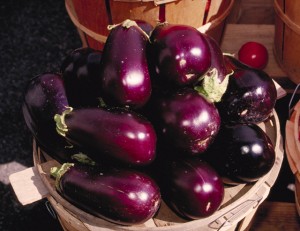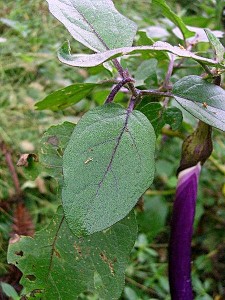 Eggplant is a plant of the family Solanaceae also known as the nightshades. As a nightshade, it is closely related to the tomato and potato. It bears a fruit of the same name, commonly used as a vegetable in cooking. Though commonly thought of as a vegetable, eggplant is actually a fruit, specifically a berry. It contains numerous small, soft seeds, which are edible, but are bitter because they contain an insignificant amount of nicotine. The fruit flesh is smooth and the thin skin is also edible, so that peeling is not required.
Eggplant is a plant of the family Solanaceae also known as the nightshades. As a nightshade, it is closely related to the tomato and potato. It bears a fruit of the same name, commonly used as a vegetable in cooking. Though commonly thought of as a vegetable, eggplant is actually a fruit, specifically a berry. It contains numerous small, soft seeds, which are edible, but are bitter because they contain an insignificant amount of nicotine. The fruit flesh is smooth and the thin skin is also edible, so that peeling is not required.
There are many varieties of this delicious food, ranging in color from rich purple to white, in length from 2 to 12 inches and in shape from oblong to round. Eggplants become bitter with age and are very perishable. They should be stored in a cool, dry place and used within a day or two of purchase. If longer storage is necessary, place the eggplant in the refrigerator vegetable drawer. Eggplant can be prepared in a variety of ways including baking, broiling and frying. It is grown in 18,000 ha all over the country, but major producers are Ilocos, Central Luzon, and Southern Tagalog.
Production of Eggplant
Varieties:
- Batangas long purple
- Bulakea
- Casino
- Claveria KS
- Dumaguete
- Jackpot
- Long purple
- Tanauan KS
- Llamado
Climatic Requirements
Eggplant can be grown from low to mid elevations throughout the year. Production is best, however, during the dry, cool months in sandy loam soil. Clay loam to clayey soils, with pH of 5.5-6.5 can also be used.
Land Preparation
Prepare land by plowing and harrowing twice. Make furrows 1.0 m apart. Spread manure along rows or hills at 1-2 handfuls per hill. Apply complete fertilizer (14-14-14) at 10-15 g/hill and cover lightly with soil.

Planting
Transplanting. Irrigate area before transplanting. Plant one seedling per hill at a distance of 0.5-1.0 m depending on variety. Provide 1.0-m-long stake to prevent lodging. Irrigate by furrow every 7-14 days depending on season and soil type.Side-dress with urea at 10 g/hill every 2-4 weeks during the vegetative stage. Use equal parts urea and 0-0-60 at the start of fruiting.Weed 2-3 times during the growing season, or as necessary. Practice mulching to minimize weed growth and maintain uniform soil moisture.
Pest Management
Avoid monocropping. Plant different varieties in one area. Intercrop with other vegetables and include repellants such as garlic, marigold, ginger, and lemon grass. In case of tip borer, remove and burn damaged shoot together with the larvae. Spray (Selecron or Trebon) at recommended rates if green leafhopper incidence is severe. Intercropping and mulching reduce the incidence of insect pests. Eggplant can be grown economically even without pesticides.
Harvesting
Harvest mature fruits which are shiny and soft. More frequent harvesting can reduce damage from fruit borers. Harvest all fruits including deformed and damaged ones to prevent spread of pests and diseases. Harvesting can last for 3-6 months. Severalvarieties can be grown for 1-2 years.
Post Harvest
Discard or bury severely infested fruits or make into compost. Grade according to market standards. Pack in crates lined with banana leaves. Do not expose to high temperatures.
Source(s): PCARRD-DOST Information Bulletin No. 147/1999,